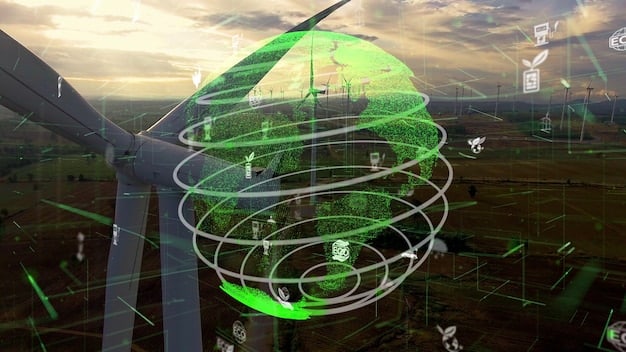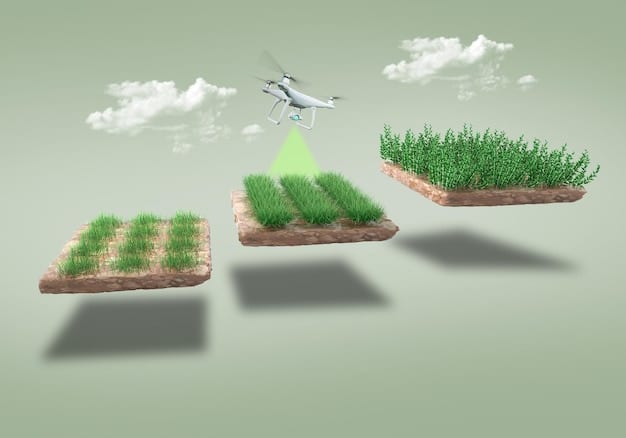AI’s Role in US Climate Change Mitigation: A Deep Dive

Artificial Intelligence offers transformative capabilities for enhancing the United States’ climate change mitigation efforts by optimizing energy systems, improving climate modeling, and accelerating the development of sustainable technologies.
The climate crisis presents an unparalleled challenge, demanding innovative solutions and concerted action. Among the various technological advancements emerging to combat this global threat, The Role of Artificial Intelligence in US Climate Change Mitigation Efforts is rapidly gaining prominence. This exploration delves into how AI, from sophisticated algorithms to machine learning models, is not just a tool but a fundamental catalyst enabling the United States to address climate change with greater precision, efficiency, and impact.
AI for Enhanced Climate Data Analysis and Prediction
Understanding climate change requires processing vast, complex datasets, a task where Artificial Intelligence excels. AI’s capacity to analyze intricate patterns and predict future scenarios is invaluable for both mitigating current impacts and anticipating future challenges. This section explores how AI transforms raw environmental data into actionable insights for policymakers and scientists.
Advanced machine learning techniques allow for the assimilation of diverse data sources, including satellite imagery, sensor networks, and historical climate records. This comprehensive data integration reveals subtle trends and anomalies that human analysis might overlook, forming a more robust foundation for climate action.
Predictive Modeling for Extreme Weather Events
One of AI’s critical contributions is its ability to improve the accuracy of extreme weather predictions. By analyzing historical weather patterns, atmospheric conditions, and oceanic data, AI models can forecast events like hurricanes, droughts, and heatwaves with unprecedented precision.
- Early Warning Systems: AI powers sophisticated early warning systems, providing communities with vital time to prepare for and respond to natural disasters.
- Resource Allocation: More accurate predictions enable better allocation of emergency resources, minimizing human and economic losses.
- Infrastructure Resilience: Predictive insights guide the development of resilient infrastructure, designed to withstand worsening climate impacts.
Attribution of Climate Impacts
AI also plays a crucial role in attributing specific weather events or long-term climate shifts to human-induced climate change. Complex algorithms differentiate between natural variability and anthropogenic influences, strengthening the scientific basis for mitigation policies.
This attribution is vital for fostering public understanding and political will, as it directly connects human activities to observable environmental changes. Such clarity supports the implementation of targeted mitigation strategies.
Optimizing Energy Systems with AI
The energy sector is a major contributor to greenhouse gas emissions, making its optimization a cornerstone of climate change mitigation. Artificial Intelligence offers transformative capabilities for improving energy efficiency, integrating renewables, and managing smart grids.
AI algorithms can analyze consumption patterns, predict demand, and dynamically adjust energy distribution, leading to significant reductions in waste and emissions. This smart management is essential for a future powered by clean, renewable energy.

Smart Grid Management
The transition to a decentralized and renewable energy system requires intelligent management. AI-powered smart grids can balance fluctuating supply from renewable sources (like solar and wind) with dynamic demand, ensuring grid stability and efficiency.
- Demand Response: AI enables real-time demand response programs, encouraging consumers to shift energy use during peak demand periods, reducing strain on the grid.
- Predictive Maintenance: Machine learning predicts equipment failures in the grid, allowing for proactive maintenance and preventing costly outages.
- Intermittency Management: AI smooths out the intermittency of renewable energy by optimizing storage solutions and predicting energy output based on weather forecasts.
Energy Efficiency in Buildings and Industry
Buildings and industrial processes consume significant amounts of energy. AI offers granular control and optimization, leading to substantial energy savings and emission reductions.
From smart thermostats that learn occupant preferences to AI-driven industrial control systems that fine-tune machinery operation, intelligent automation minimizes energy waste. This extends to optimizing heating, ventilation, and air conditioning (HVAC) systems, lighting, and industrial motor efficiency.
Accelerating Renewable Energy Development and Integration
For the US to achieve its climate goals, a rapid and massive scale-up of renewable energy is imperative. AI is proving to be a powerful ally in every stage of this transition, from site selection and design to operational efficiency and grid integration.
The complexity of renewable energy projects often involves optimizing numerous variables, such as wind patterns, solar irradiation, geographical constraints, and economic viability. AI’s ability to process and synthesize these factors makes it an indispensable tool.
Optimizing Site Selection and Design
Finding the ideal locations for solar farms or wind turbines is crucial for maximizing energy output and minimizing environmental impact. AI algorithms analyze vast geological, meteorological, and topographical data to identify prime sites.
- Resource Assessment: AI models predict long-term wind speeds and solar irradiance with high accuracy, ensuring projects are sited where resources are most abundant.
- Environmental Impact: AI can simulate the potential environmental impact of proposed sites, helping developers avoid sensitive ecosystems.
- Cost-Benefit Analysis: Machine learning tools assist in comprehensive cost-benefit analyses, optimizing design for maximum efficiency and return on investment.
Improving Operational Efficiency of Renewables
Once deployed, AI continues to enhance the performance of renewable energy assets. Predictive maintenance and intelligent control systems ensure that solar panels and wind turbines operate at their peak efficiency.
Sensors on turbines and solar arrays feed data to AI systems, which can detect subtle performance degradation, predict component failures, and optimize blade angles or panel orientation in real-time based on prevailing conditions. This proactive approach significantly extends asset lifespan and maximizes energy generation.
AI in Carbon Capture, Utilization, and Storage (CCUS)
Beyond reducing emissions from existing sources, carbon capture, utilization, and storage (CCUS) technologies are becoming increasingly important for mitigating hard-to-abate industrial emissions and achieving net-zero goals. AI offers promising avenues for enhancing the efficiency and viability of CCUS processes.
The complex chemical and engineering processes involved in capturing, transporting, and storing carbon dioxide benefit greatly from AI’s capability to model, predict, and optimize intricate systems. This includes reducing the energy penalty associated with capture and identifying suitable storage sites.
Enhancing Capture Efficiency
Capturing CO2 from industrial flue gases or directly from the air is an energy-intensive process. AI can optimize the design and operation of capture plants, reducing the energy required and increasing throughput.
- Material Discovery: Machine learning algorithms can accelerate the discovery of new, more efficient materials for CO2 capture, such as novel sorbents and membranes.
- Process Optimization: AI models can predict the optimal operating conditions for capture units, adjusting parameters like temperature, pressure, and solvent flow rates in real-time.
- Fault Detection: AI can detect subtle anomalies in plant operation that indicate inefficiencies or potential failures, allowing for proactive adjustments.
Site Selection and Monitoring for Storage
For CO2 storage to be effective and safe, geological sequestration sites must be carefully selected and continuously monitored. AI provides sophisticated tools for both these critical aspects.
Geospatial analysis powered by AI can evaluate seismic data, rock formations, and fluid dynamics to identify sites with the highest potential for long-term, secure CO2 storage. Once storage begins, machine learning algorithms analyze sensor data from injection wells to monitor plume migration, detect potential leaks, and ensure geological integrity over decades.
AI for Sustainable Agriculture and Land Use
Agriculture and land use practices are significant sources of greenhouse gas emissions (e.g., methane from livestock, nitrous oxide from fertilizers, CO2 from deforestation). AI offers targeted solutions to make these sectors more sustainable and climate-friendly, while also enhancing food security.
Precision agriculture, enabled by AI, allows for optimized resource use, reducing the environmental footprint of farming. Similarly, AI can track and monitor land use changes, providing critical data for conservation efforts.

Precision Agriculture
AI-driven precision agriculture revolutionizes farming by allowing for highly targeted application of resources, minimizing waste and emissions.
- Optimized Fertilizer Use: AI analyzes soil data, weather patterns, and crop health to recommend precise fertilizer application, reducing nitrous oxide emissions.
- Efficient Irrigation: Machine learning models predict crop water demand and soil moisture levels, enabling smart irrigation systems that conserve water.
- Disease and Pest Detection: AI-powered imaging and sensors can detect crop diseases and pests early, allowing for targeted treatment and reducing the need for broad-spectrum pesticides.
Forestry and Land Use Monitoring
Forests are vital carbon sinks, and their protection and restoration are critical for climate mitigation. AI plays a crucial role in monitoring deforestation, promoting reforestation, and managing natural ecosystems.
Satellite imagery combined with AI algorithms can track deforestation rates in real-time, identify illegal logging, and monitor the health of forests. This data supports conservation efforts and helps verify carbon sequestration projects. AI can also optimize tree planting strategies for reforestation, considering species suitability and climate resilience.
Advancing Climate-Resilient Infrastructure and Policy
As climate change progresses, adapting to its impacts and building resilient infrastructure become as critical as mitigation. AI provides analytical tools to inform these adaptations and shape effective climate policies, ensuring that investments are strategic and impactful.
The complexity of interconnected systems—from urban planning to national energy grids—demands sophisticated analysis that AI can provide. This includes vulnerability assessments, optimization of adaptation measures, and simulation of policy impacts.
Vulnerability Assessment and Adaptation Planning
AI helps identify communities and infrastructure most vulnerable to climate impacts (e.g., sea-level rise, extreme heat, flooding). By analyzing geospatial data, demographic patterns, and climate projections, AI creates detailed vulnerability maps.
- Targeted Interventions: These assessments guide the allocation of resources for adaptation, ensuring that at-risk areas receive priority for protective measures.
- Infrastructure Design: AI informs the design of new infrastructure, making it more resilient to future climate conditions, such as stronger storm surge barriers or heat-resistant materials.
- Early Warning Systems: For specific climate hazards, AI enhances localized early warning systems, improving preparedness and evacuation capabilities.
Policy Formulation and Evaluation
Effective climate policies require a deep understanding of complex interactions across economic, social, and environmental systems. AI assists policymakers by modeling the potential outcomes of different policy choices.
Simulation models powered by AI can forecast the economic impact of carbon pricing, the effectiveness of renewable energy incentives, or the social equity implications of climate regulations. This quantitative analysis provides crucial evidence for robust and equitable policymaking. It allows for the iterative refinement of strategies to achieve climate goals efficiently and fairly.
The integration of AI into these processes ensures that the United States is not just reacting to climate change, but strategically building a more resilient and sustainable future. From urban planning to national security, AI-driven insights provide the foresight needed to proactively mitigate risks and seize opportunities for climate action.
| Key Area | AI’s Contribution |
|---|---|
| 📊 Data Analysis & Prediction | Enhances climate modeling, extreme weather forecasting, and impact attribution. |
| ⚡ Energy System Optimization | Enables smart grids, integrates renewables, and improves energy efficiency in buildings. |
| 🌳 Sustainable Land Use | Powers precision agriculture and monitors deforestation/reforestation efforts. |
| 🏙️ Resilient Infrastructure | Informs vulnerability assessments and guides policy for climate adaptation. |
Frequently Asked Questions About AI and Climate Change Mitigation
AI significantly enhances climate modeling by processing vast, complex datasets from satellites, sensors, and historical records. Machine learning algorithms can identify subtle patterns and correlations that human analysts might miss. This leads to more precise predictions of climate trends and extreme weather events, improving the reliability of climate projections for policy and planning.
Yes, AI is crucial for integrating intermittent renewable energy sources like solar and wind into the grid. AI-powered smart grids can predict energy demand and renewable output, optimizing energy flow and enabling real-time balancing. This ensures grid stability and efficiency, reducing reliance on fossil fuel “peaker” plants and accelerating the transition to clean energy.
AI contributes to carbon capture, utilization, and storage (CCUS) by optimizing process efficiency and accelerating material discovery. Machine learning algorithms can identify new, more efficient sorbents for capturing CO2. AI also fine-tunes operating parameters in capture plants to reduce energy consumption, making CCUS more economically viable and scalable for industrial emissions.
AI enables precision agriculture, minimizing the environmental footprint of farming while maintaining productivity. It optimizes fertilizer and water use based on real-time data, reducing greenhouse gas emissions like nitrous oxide. AI also helps detect crop diseases and pests early, leading to targeted interventions and less reliance on broad-spectrum chemicals, fostering sustainable land use.
Absolutely. AI assists in building climate-resilient infrastructure by conducting detailed vulnerability assessments. It analyzes environmental and demographic data to identify areas at highest risk from climate impacts like sea-level rise or extreme heat. This information guides urban planners and engineers in designing and retrofitting infrastructure to withstand future climate challenges, ensuring long-term safety and sustainability.
Conclusion
The journey towards a sustainable future in the United States is complex and multifaceted, but Artificial Intelligence offers a powerful suite of tools to accelerate progress. From refining climate models and optimizing energy grids to enhancing carbon capture and promoting sustainable land use, AI’s capabilities are redefining what’s possible in climate change mitigation. It enables a data-driven approach, fostering efficiency, precision, and innovation across critical sectors. As the US continues to navigate the complexities of environmental stewardship, AI is not merely a supplementary technology but an indispensable partner, driving the nation toward a more resilient, low-carbon economy. Its transformative potential underscores a future where technology and environmental responsibility converge to address one of humanity’s greatest challenges.





